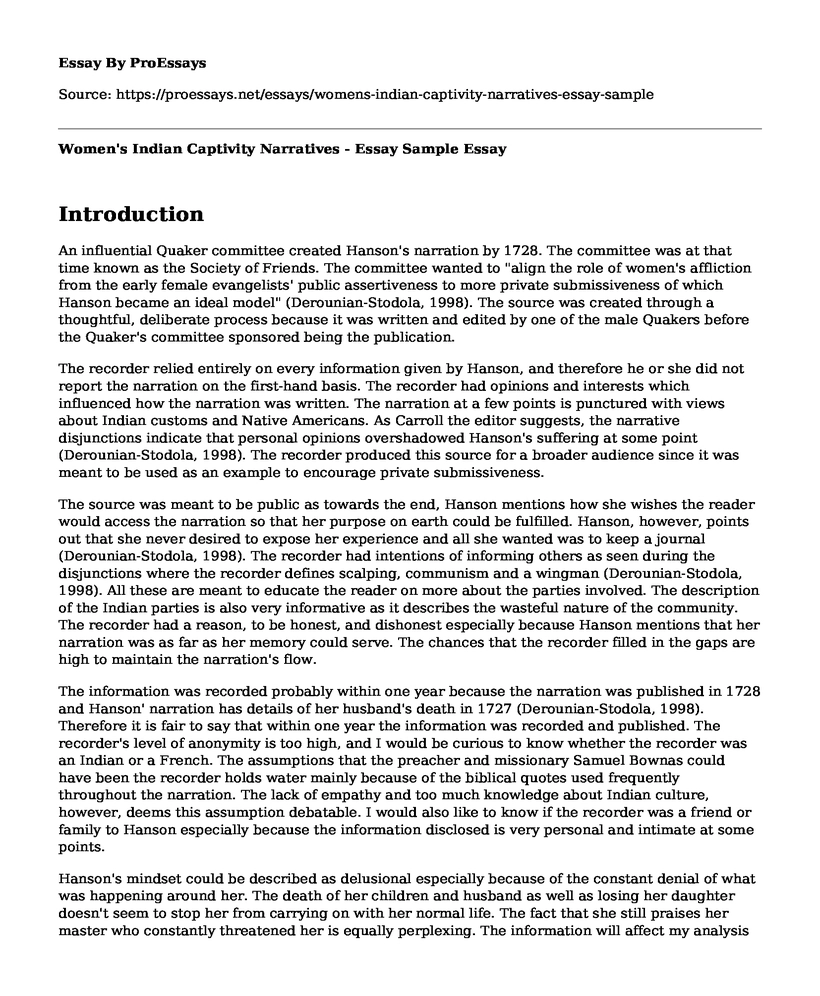Introduction
An influential Quaker committee created Hanson's narration by 1728. The committee was at that time known as the Society of Friends. The committee wanted to "align the role of women's affliction from the early female evangelists' public assertiveness to more private submissiveness of which Hanson became an ideal model" (Derounian-Stodola, 1998). The source was created through a thoughtful, deliberate process because it was written and edited by one of the male Quakers before the Quaker's committee sponsored being the publication.
The recorder relied entirely on every information given by Hanson, and therefore he or she did not report the narration on the first-hand basis. The recorder had opinions and interests which influenced how the narration was written. The narration at a few points is punctured with views about Indian customs and Native Americans. As Carroll the editor suggests, the narrative disjunctions indicate that personal opinions overshadowed Hanson's suffering at some point (Derounian-Stodola, 1998). The recorder produced this source for a broader audience since it was meant to be used as an example to encourage private submissiveness.
The source was meant to be public as towards the end, Hanson mentions how she wishes the reader would access the narration so that her purpose on earth could be fulfilled. Hanson, however, points out that she never desired to expose her experience and all she wanted was to keep a journal (Derounian-Stodola, 1998). The recorder had intentions of informing others as seen during the disjunctions where the recorder defines scalping, communism and a wingman (Derounian-Stodola, 1998). All these are meant to educate the reader on more about the parties involved. The description of the Indian parties is also very informative as it describes the wasteful nature of the community. The recorder had a reason, to be honest, and dishonest especially because Hanson mentions that her narration was as far as her memory could serve. The chances that the recorder filled in the gaps are high to maintain the narration's flow.
The information was recorded probably within one year because the narration was published in 1728 and Hanson' narration has details of her husband's death in 1727 (Derounian-Stodola, 1998). Therefore it is fair to say that within one year the information was recorded and published. The recorder's level of anonymity is too high, and I would be curious to know whether the recorder was an Indian or a French. The assumptions that the preacher and missionary Samuel Bownas could have been the recorder holds water mainly because of the biblical quotes used frequently throughout the narration. The lack of empathy and too much knowledge about Indian culture, however, deems this assumption debatable. I would also like to know if the recorder was a friend or family to Hanson especially because the information disclosed is very personal and intimate at some points.
Hanson's mindset could be described as delusional especially because of the constant denial of what was happening around her. The death of her children and husband as well as losing her daughter doesn't seem to stop her from carrying on with her normal life. The fact that she still praises her master who constantly threatened her is equally perplexing. The information will affect my analysis since after reading the narration, I have three points of view to it; mine, the recorder's and Hanson's.
Conclusion
I could use this source, especially when covering a topic concerning slavery. The information above would also help me in describing the power of information, and I agree with the author that this qualifies to be one of the most rewritten and reprinted narration. Sources help in structuring a thesis statement because they contain the subject and opinions that relate to the thesis statement. General and educational knowledge should offer enough background on a source to make it valid and pertinent. Knowledge is power; the best source would be scholarly sources since they contain verified and professional information.
Reference
Derounian-Stodola, K. Z. (Ed.). (1998). Women's Indian Captivity Narratives. Penguin.
Cite this page
Women's Indian Captivity Narratives - Essay Sample. (2022, Nov 22). Retrieved from https://proessays.net/essays/womens-indian-captivity-narratives-essay-sample
If you are the original author of this essay and no longer wish to have it published on the ProEssays website, please click below to request its removal:
- Pluralist and Power Elite Model of America on Sociology - Essay Example
- Ethical Dilemmas and Ethical Decision Making Essay
- Anthropology of Gender Essay
- Essay Sample on Effects of Social Media to the Society
- Essay Example on Parents: Experiencing Miscarriage
- Essay Example on Gender Parity: The Emergence of Work-Life Balance
- Youth Homelessness - Research Paper Sample







